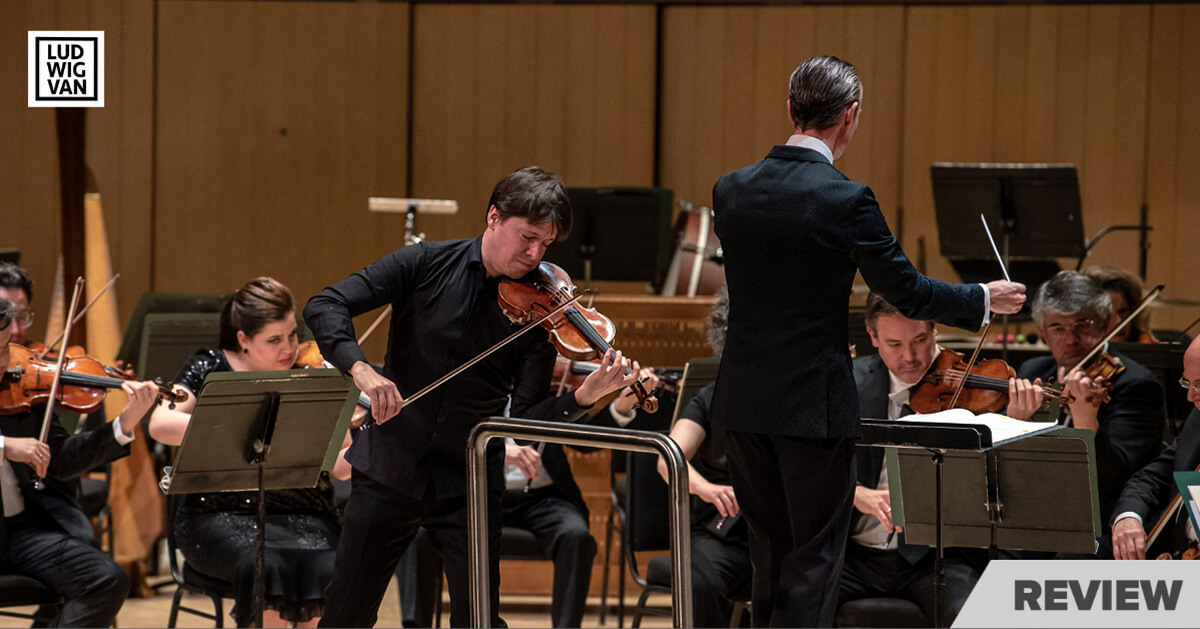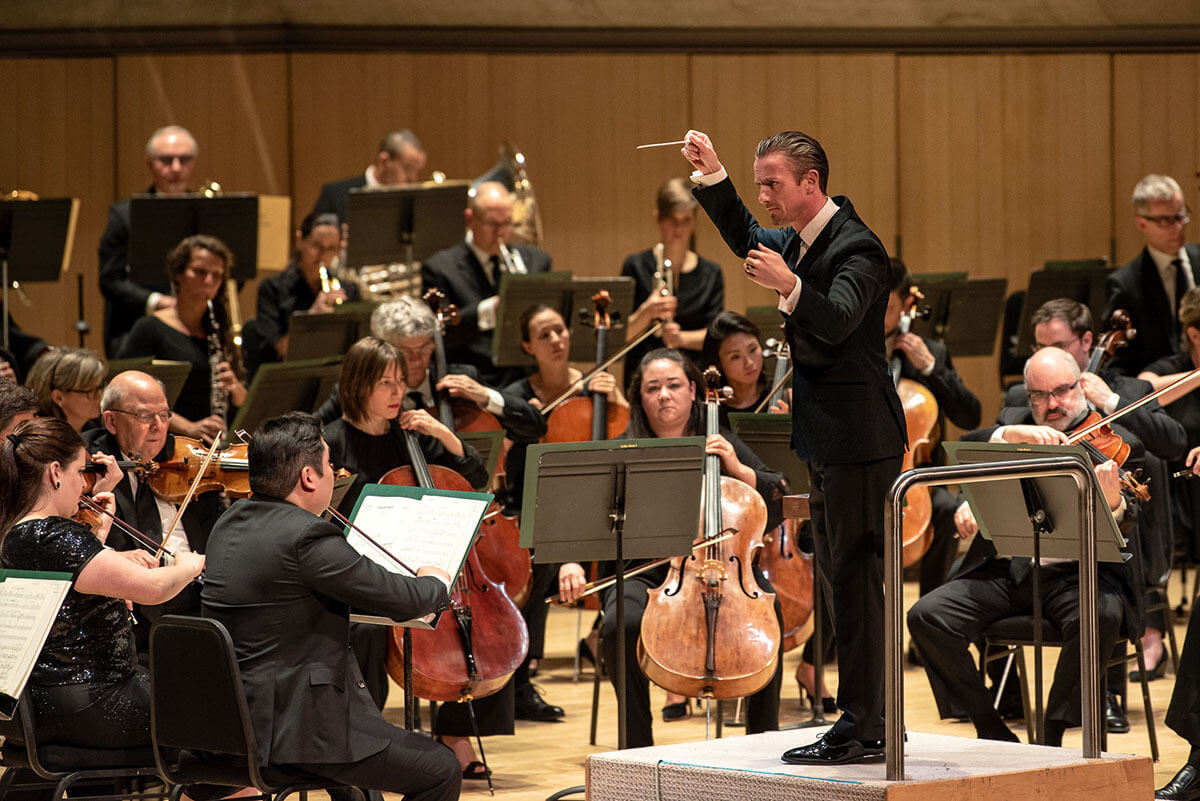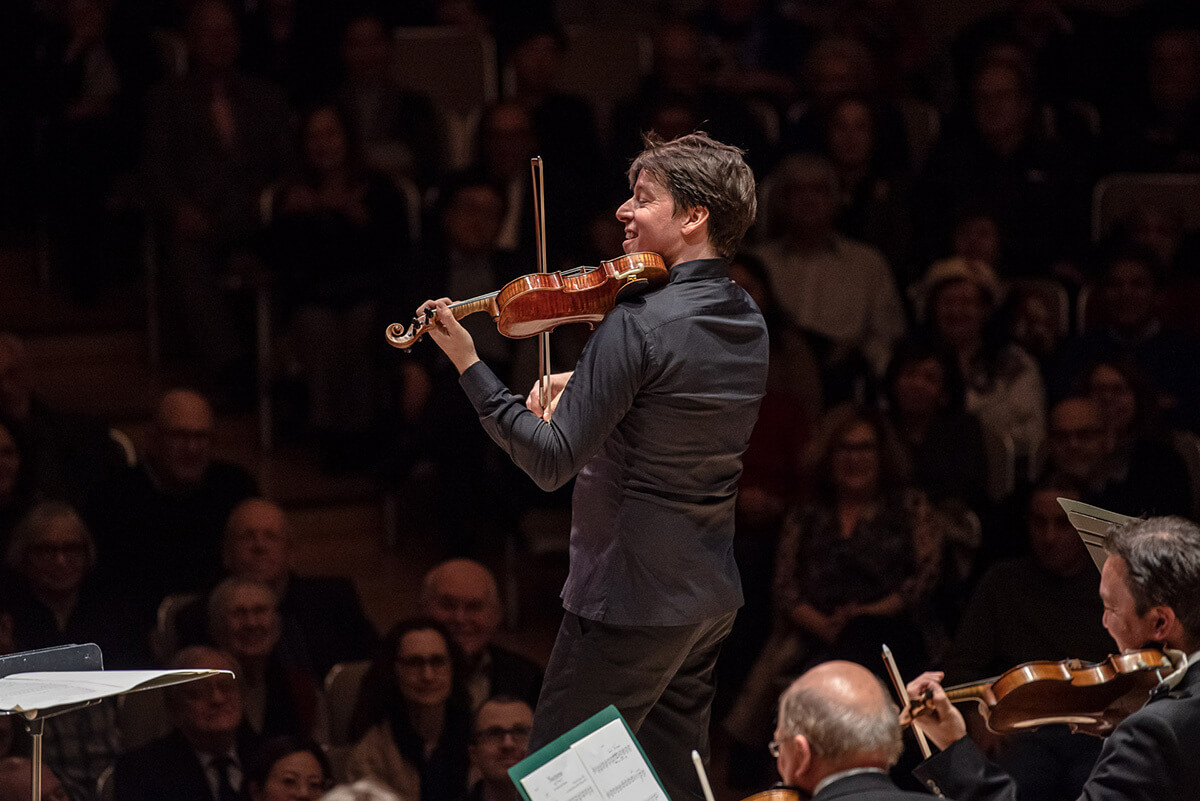
L. Boulanger: D’un soir triste; Mendelssohn: Violin Concerto; Jocelyn Morlock: My Name Is Amanda Todd; Debussy: La mer. Alexander Shelley, conductor; Joshua Bell, violin; National Arts Centre Orchestra. Roy Thomson Hall, 8 p.m. February 6, 2020.
When an ensemble such as the National Arts Orchestra of Canada (NACO) embarks on a tour, there is a trust that an ensemble as fine as this one from the nation’s capital will provide audiences with something of our Canadian identity, whether in whole or in part. A splendid example certainly was their impressive, 2017 multimedia tour titled Life Reflected, an exemplary commission of four women composers who were tasked to write about influential women who had become central to Canadian culture at that time.
This time, the theme of NACO’s current mini-tour to Toronto was different, selecting two women composers for a playbill of lush orchestral works. One of those compositions was retained from the successful Life Reflected tour, namely Jocelyn Morlock’s very difficult essay on a terrible and ongoing chapter in social history pertaining to an infamous case of cyberbullying, the symphonic elegy My Name is Amanda Todd.
Morlock’s tribute led off the second half of the concert and I found it thoughtful and moving. Under the direction of conductor Alexander Shelley, the piece soared.
The piece is straightforward in its intent, specifically designed to paint the life of Amanda Todd in vignette form from the tremendous pain of her passing to the inspiration her story has provided. The use of musical idiom and harmonic scope were impressive, not particularly static or minimalist at all as has been reported, but rather the compositional narrative searched for, and eventually found, what seemed like a musically evocative pathway for all to approach Amanda Todd’s story.
The musical journey reads as both Amanda’s and anyone else’s who has been bullied, and seems to culminate specifically for those who triumphed over the many lifelong problems associated with its jarring cruelty. The influence of Amanda Todd’s videos, used now to help young people recover from the effects of cyberbullying, seems to be embedded in the transformative conclusion of Morlock’s symphonic elegy, a brave and appropriate touch. The overall impression is of a piece succeeding as both story and safe space all at once — an impressive accomplishment within a limited amount of musical time.
The effect was sweetened by a parsimonious use of theme throughout, without resorting to unidimensional tone painting. The orchestration sticks to the storyline but is imaginative, inflected with colour, delivering sterling results as a strong standalone piece. Originally presented with accompanying video collage, My Name is Amanda Todd worked very well last night as pure orchestral statement, and could work even if one did not know anything about the general narrative movement associated with how Amanda’s life is viewed today, one moving from tragedy to redemptive impact.
One final point to make is that Morlock’s elegy for Amanda Todd and all who endure what she had to endure, needs to be read as such: it is a compositionally deft handling of a difficult topic that immerses complexity into eloquent poignancy. I would have found such a project difficult to compose. I admire Jocelyn Morlock for her fine accomplishment.

A perfect complement was the symphonic study leading off the concert programme, the personal elegy D’un soir triste by Marie-Juliette (“Lili”) Boulanger, Nadia Boulanger’s younger sister, who died at the age of 24. She was the first woman to win the Prix de Rome and her musical language and compositional technique, in many ways, stood ahead of their time.
I have heard some of her Psalms and her style has always struck as breathtaking, lucid and self-confident. NACO conductor Alexander Shelley gave a brief address to the audience about Boulanger, stating that we will never know how much she would have accomplished had she survived her debilitating illnesses.
But I think we can be more bold: it is fair to extrapolate, especially after hearing D’un soir triste, her autobiographical struggle with her own impending death, that this essay solidifies her place as one of the great composers of the first half of the century. While it is clear that her music was tonally grounded, it was also texturally magnificent and sonically adventurous at nearly every level. Her orchestration, by 1918, was equivalent to or even beyond most of her contemporaries. She took influences from composers of the previous decade and rendered them anew, unafraid to try new things. Her music would have been welcome in Paris, especially during the decade after the war. D’un soir triste almost seems to have anticipated some of Aaron Copland’s language. There was no doubt that its performance gave the orchestra another tremendous success. What a superb way to lead off the concert.
The next great story of the night was Joshua Bell’s return to Roy Thomson Hall after his widely successful solo recital last April of three violin sonatas. We were all anticipating his performance of the Mendelssohn Violin Concerto in E minor, a work seemingly written for his type of musicianship and deeply innate sense of unremitting, refined tone.
Bell’s almost intimate relationship with the concerto carries a backstory of its own. Tiring of playing the work, he dropped it from his concerto repertoire for several years until he felt assured that each time he were to play it he could expose aspects of this repertoire staple with due freshness. As expected, he substituted Mendelssohn and David’s standard cadenza with his own: a bravura, nearly continuous, double-stopped technical marvel. He followed the concerto with an encore, again his own arrangement, this time of the Chopin Nocturne in E-flat major.
Bell is widely and appropriately recognized as a special kind of musician, precisely because his violin exudes creamiest warmth, a latte on a cold day with still more in the cup to scoop away when the coffee’s all gone. When you hear Joshua Bell, you know it’s him and it’s impossible to confuse his unique sound with any other violinist out there today.

It was awe-inspiring to witness his unique technique once more, unfettered through all three movements. He played perfectly with the orchestra, phrasing to every harmonic moment. The reduced ensemble was responsive under the baton of Shelley’s granular approach to each note and phrase of the score. The performance was a meticulous one, often highly impressive.
The joint effort resulted in a complete success, a strong union not only of artist and conductor but of interpretation with compositional maturity. Like the Boulanger work which preceded it, this was Mendelssohn’s last great orchestral work, and it was taken as such, marrying the composer’s final, late Classical tribute authentically well with Romantic effulgence. We could hear it for the touchstone that it is in the violin repertoire.
Most important of all was that so many elements of this interpretation came together so well under close examination from all instrumental sections The winds were sparkling, the brass forceful and the strings mysterious and brooding in the first movement, lyrical at theme two in G and then in the second movement, and sounded ready to start a revolution by the middle of the third. It was an inspired, beautiful performance no one will soon forget.
Such a close examination of a work’s multiple elements did not meet with scrupulous unity to the same extent, however, in Debussy’s La Mer, the evening’s final work.
The orchestra certainly played it technically well enough, phrased it well enough, swelled at the key moments with fine power and control. They even provided many of the literary and visual elements which inspired Debussy when he wrote the three-movement work, such as Hokusai’s famous drawing “Wave,” providing a pleasing timbral fecundity many times throughout the work’s twenty-three minutes.
But conspicuously missing was the development of Debussy’s longest fascinations with the symphonic vehicle itself, regardless of what he titled his works in the genre. He wrote a symphony when he was just eighteen years old but regretted never orchestrating it himself, so whenever he had the opportunity to write in the genre, he was unstinting in developing his own uniquely French (read “unGerman”) language in this exacting medium. In addition, Debussy’s impressionist imperative, driven toward harmonic and rhythmic drift, including his veritable need to pulverize the downbeat and fully obscure the bar line, were missing from this performance. The notes were there, but the French feel was not. This was more a Debussy brought to heel than brought to life.
With La Mer, Debussy had scaled new heights in the orchestral repertoire. Thematic development, which in these pieces had come to exist in the tiniest of fragments, received far too much attention in this interpretation. At this point, Debussy had begun to push forward to create a new kind of orchestral piece which would expose and re-expose a theme, while eschewing thematic development in favour of timbre as narrative impetus. He assiduously avoided arriving at some definitive formal “goal” at any point in the composition as a means for painting the endlessness of the sea, a new idea of considerable genius.
But last night, I felt the work continuously pushing forward and “arriving” at many artificially induced points, as if the work had been collectively shaped into a pro forma conception.
A grand sound was always there, but Debussy’s very personality was absent. That was too bad given the stunning job the NACO did with the rest of the concert programme.
#LUDWIGVAN
Want more updates on classical music and opera news and reviews? Follow us on Facebook, Instagram or Twitter for all the latest.
- SCRUTINY | Opera Atelier’s Film Of Handel’s ‘The Resurrection’ A Stylish And Dramatic Triumph - May 28, 2021
- HOT TAKE | James Ehnes And Stewart Goodyear Set The Virtual Standard For Beethoven 250 - December 15, 2020
- SCRUTINY | Against the Grain’s ‘Messiah/Complex’ Finds A Radical Strength - December 14, 2020



